Crown’s first Energy Storage Sustainability Guide and Progress Report
A Roadmap for Environmentally Conscious Battery Users
If you want an objective education about energy storage sustainability – don’t ask a marketer.
Hold that thought.
Is your company or household committed to strong goals for climate, environment, and sustainability, including from battery suppliers?
If so, you could ask battery companies questions like, “What kind of sustainability programs do you have in place?”
But that’ll only get you so far.
Because the people who answer those questions are typically marketers. And it’s their job to present their products in the best light – to sell them.
Let’s debunk these common claims, for example:
MARKETER: “Our new XYZ batteries are green.”
US: “‘Green’ doesn’t mean anything because there’s no legal definition for it. And those batteries are only recycled 5% of the time. It’s strange that we found that data in a Department of Energy report, but it wasn’t mentioned in the battery brochure.”
MARKETER: “Our goal is to use 50% recycled materials.”
US: “That’s wonderful marketing and a great goal. But a goal isn’t legally binding, and it isn’t happening today. In fact, you’re still using 95%+ virgin mined materials in your batteries. And we can’t find any documentation of a feasible plan to change that in the next 5 to 10 years.”
MARKETER: “Our eco batteries are designed for renewable energy and electric vehicles...”
US: “... and built using electricity from fossil fuels.”
Look, it’s tough to separate battery facts from marketing hype – and it’s not our fault:
-
-
-
- There’s too much information. We’re expected to read and synthesize more information in a year than our ancestors saw in an entire lifetime.
- There’s too little time. Yes, you’re smart. And you’re probably tasked with battery decisions. But chances are good you also have dozens of other projects on your plate – and countless emails and video meetings.
- We’re too busy to know where to start. And most easy to read sustainability documents are just corporate brochures.
- It’s hard to tell which information is accurate and useful. Here’s why: The battery industry is in the middle of an investment gold rush, and some companies are making aggressive claims about their “green” efforts to get more publicity. (If you hear “100% recyclable” or “green” or “ten year life” without independent proof – run away!)
- We don’t know which questions to ask to improve our energy storage sustainability.
-
-
So how do you know whether your batteries are green – or just greenwashed?
If you really want to reduce your batteries’ environmental footprint – and your operating costs – ask a scientist or sustainability expert.
That’s what we did.
More than a decade ago, we teamed up with energy efficiency experts and sustainability auditors and scientists.
Since then, we’ve invested more than $8 million heavily in sustainability programs. Contracted with experts from across the country. Collaborated with the Department of Energy scientists and Fortune 500 operations managers. And scoured hundreds of research papers and ESG reports.
We’ve been amazed by how much there is to learn – and how much we could improve our energy efficiency and lower emissions.
And if you want to shave years off your learning curve, we’ve synthesized the critical sustainability information into a single, easy to follow guide.
Get your copy of the Energy Storage Sustainability Guide now.
Today, we use 100% renewable energy for manufacturing, build batteries with roughly 80% previously recycled materials, and consume less electricity while producing more batteries.
But you don’t have to spend seven figures or hundreds of hours to figure out how to select environmentally friendlier batteries.
Because after years of development and months of writing, we’re finally pulling back the curtain for you.
Crown’s Energy Storage Sustainability Guide covers all the basics you need to reduce your batteries’ carbon footprint and your energy bill – with none of the marketing hype, technical jargon, or business-speak.
Here’s some of what you’ll discover:
-
-
- Which batteries are 99% recycled, and which are 95% landfilled? (sources: US EPA, International Energy Agency, and US Department of Energy)
- How does a manufacturer’s “energy mix” drastically impact battery sustainability?
- Employee Safety, Clean Water and Air: Which policies, equipment, and training protect workers and the community?
- Avoid the leading cause of early battery failure with proven tips
- Checklist: Key design features for battery longevity, regardless of brand
- Questions to spot marketing hype and greenwashing before you select batteries
-
You’ll also get behind-the-scenes insights and lessons learned from Crown Battery’s global sustainability program.
Want to know how we switched to 100% renewable energy for manufacturing – and didn’t pay any more per kilowatt-hour? It’s in the Guide.
Want to be the first person in your company who can explain why some batteries are made using previously recycled materials, while others require virgin mining? It’s in the Guide.
Want five steps to reduce your energy bill and CO2 emissions – no matter what industry you’re in, no matter what building or operation you run? You guessed it: It’s in the Guide.




